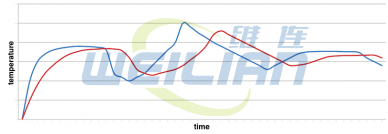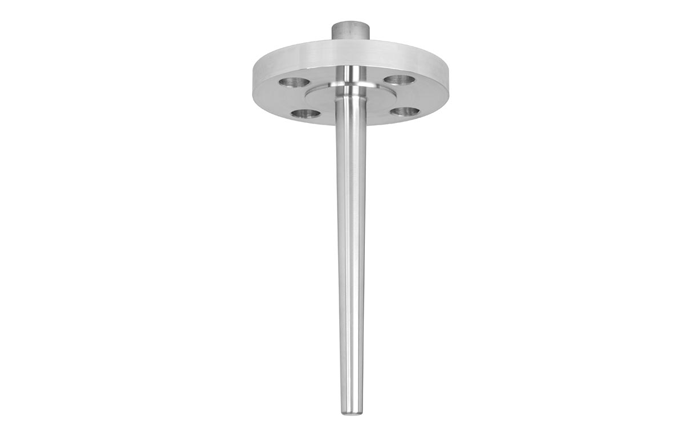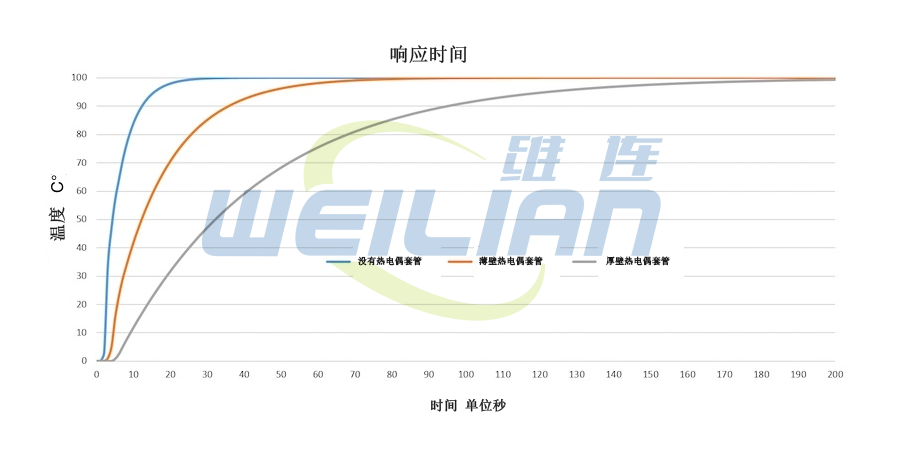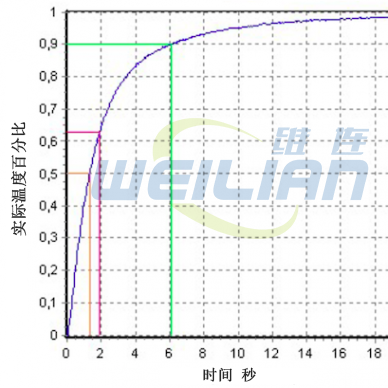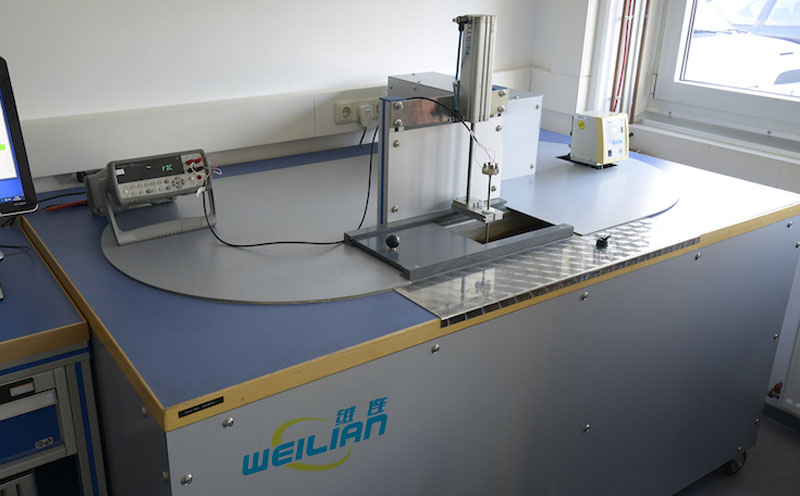 Temperature sensor, thermowell and response time
Temperature sensor, thermowell and response timeThe thermowell protects the temperature sensor from harsh media. The downside is that these accessories increase the thermal response time. Therefore, accurate understanding of response time becomes a key factor in controlling processes and systems.
Figure 1: The measured temperature (red curve) always lags behind the actual temperature (blue curve).
In the real world, even the best thermometers cannot respond immediately to temperature changes in industrial processes. On the one hand, the heat in the medium takes time to reach the sensor. Each part of the measurement system also has a heat dissipation problem. Therefore, the measured temperature always lags behind the actual temperature. This time difference may be only a few seconds or as long as a few minutes, but the delay is inevitable and should be taken into account when selecting the temperature system.
Many factors affect the response time of the temperature measurement system:
●Type, size and material of temperature sensor
●Distance of the sensor inserted into the medium
●Type of medium (liquid, gas, surface, etc.)
In addition, many industrial processes require temperature sensors to be placed in thermowells, which also increases response time.
In some processes, such as hydrocracking, slow response times can mean big trouble. For example, if the process temperature rises rapidly - a runaway condition - the temperature may exceed the design limits of the steel container and cause catastrophic failure before the sensor can detect the change.
What is a thermowell and when to use it
The flanged TR10 thermal sleeve is specially designed for the petrochemical industry.
The thermowell is a metal fitting designed to protect the temperature sensor. These cylindrical fittings can be made of different materials - stainless steel, copper alloy, heat-resistant steel, etc. - and are available in various sizes and thicknesses depending on the process. Thermowells are typically used in pipelines, petrochemical processes, onshore/offshore applications, compressors, and syngas plants to protect electronic thermometers from:
●Corrosive and/or abrasive media
●Fast moving media
●extreme pressure
Another benefit of thermowells is that they allow technicians to replace, calibrate, and inspect sensors without interrupting the work process.
How the thermowell affects the temperature response time
Adding a thermal sleeve to the temperature measurement system means that there is another layer of material through which heat must pass, as well as more opportunities for heat dissipation. The factors affecting the response time and accuracy are the material, thickness and overall size of the thermal sleeve. Wider, thicker wall thermowells increase heat dissipation.
Figure 2: Response time of sensor X without thermowell (blue curve), thin thermowell (orange curve) and thick thermowell (gray curve).
The ideal balance may be to simply use a narrow, thin-walled thermal sleeve, which has faster response time and better accuracy than a thicker thermal sleeve, but may not be strong enough for some processes. The global demand for strength calculation of thermal sleeve is getting higher and higher, which will affect the design of thermal sleeve. A new version of the standard (e.g. ASME PTC 19.3 TW-2016) usually results in a shorter and thicker thermal sleeve size.
How to measure thermal response time
There are four ways to measure the response time of an electronic thermometer: in flowing water, in flowing air, on a surface, or in a solid. Temperature measurement guidelines are provided in ASTM E644-11 (Standard Test Method for Testing Industrial Resistance Thermometers) and ASTM E839-11 (Standard Test Method for Sheathed Thermocouples and Sheathed Thermocouple Cables).
Let's take a closer look at the measurement in water.
Response time of thermowell using flowing water method
Thermal response time measurement by flow method using a circulating water bath
In this test, water is the medium. It moves in laminar flow (as opposed to turbulence) at a rate>0.2 m/s and maintains a constant temperature. The temperature sensor moves very quickly from the initial ambient temperature (T 1) between 5 ° C and 30 ° C to the flowing water at T 2. Measure and record the time required from T 1 to T 2.
The test uses three configurations:
1 Electronic thermometer without thermowell
2 Electronic thermometer with thin wall thermowell
3 Electronic thermometer with thick wall thermowell
Figure 3: Time required to reach 50% (orange), 63% (red) and 90% (green) of the actual temperature.
... and measure three comparison thresholds:
1 50% of actual temperature (t 5)
2 63% of actual temperature (t 63)
3 At 90% of actual temperature (t 9)
The response time graph is generated according to the measurement results. The 100% value was not determined because it never reached.
How to select thermal sleeve
Applications in the process industry are usually very specific and customized, and the response time cannot be compared with standard products. If the response time is critical to the process, it must first be determined in the laboratory.
The challenge in selecting and designing temperature measurement systems is to harmonize process parameters and requirements with the best possible performance and the lowest possible cost. For critical safety systems, please contact our temperature experts for expert advice on electronic thermometers, thermowells, and temperature measurement solutions suitable for your process. 18717811268 Huang Gong sales@weilianchina.com WeChat scanning code to add sales engineer

 Temperature sensor, thermowell and response time
Temperature sensor, thermowell and response time